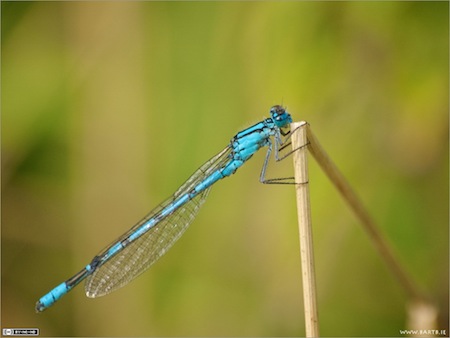Nov
24
Photo of the Week 145 – The Common Blue Damselfly
Filed Under Photography on November 24, 2010 at 5:48 pm
Last summer I mostly concentrated on wild flowers and Butterflies, this summer, I concentrated on Butterflies, Dragonflies and Damselflies. I’ve already shared a lot of my Butterfly shots in this series, and a Dragonfly one earlier in the year, so now I thought I’d share one of my favourite Damselfly shots from this summer.
This little guy is a male Common Blue Damselfly (Enallagma cyathigerum). As their name suggests this species are very blue, and not very rare, at least not along the banks of the Royal Canal. There is a complication though, there are three common species of blue damselfly along the canal, and they can look very similar to each other indeed! The key to telling them apart is the exact details of their markings. This angle doesn’t show it very well, but the Common Blue has a club-shaped black mark on the first segment after the wings. If you look carefully you can just about see it in this shot. If that club-shaped marking were to be u-shaped instead, then this would be an Azure Damselfly (Coenagrion puella).
These guys are smalL shy, and very fast, which makes them quite challenging to photograph. I don’t have a traditional macro lens anyway, but if I did, I don’t think I’d use it for Damselfly shots anyway. All my Damselfly (and most of my Butterfly) shots are taken with my trusty 55-200mm zoom, usually at full stretch at 200mm. Using a zoom rather than a macro lets me get closeup shots from a little further away, though it does come at a price. Zoom lenses compress distance, and the closer you are to your subject, the more pronounced this effect is. This results in a very shallow depth of field, so you need to stop down quite a bit before you get enough depth to get meaningful shots. Zooming in also magnifies any little shake in your hand, so as well as using a small aperture to get the DOF, you also have to use a fast shutter speed to get sharp focus. Both a small aperture and a fast shutter cut down the light a lot, so you really need a lot of light to get the shot – so, you generally need to shoot on sunny afternoons. This is not that big of a problem though, because Damselflies like the sun too! With a lot of patience and perseverance, and perhaps a little luck, you can get some nice shots of these wonderful insects without the need for fancy expensive kit.
As I tried more and more damselfly shots over the summer, I soon got plenty of sharp ones, but the problem was getting a good background. These little fellas like to hide between long grass, so you tend to get grass poking into the frame all over the place, causing a lot of clutter in the background, and often even sticking in front of parts of the insect’s body, wings or tail. My perseverance paid off though, and later in the summer I got lucky when this guy posed for me on the tallest blade of grass along a bank – he was close to eye-level, and was happy to sit there while I got close enough to get this shot. Because he was on the tallest blade of grass, there was no clutter to get in the way, and I was able to angle the camera to get the nearest background object to be far enough away to be fully out of focus, giving this nice uncluttered shot
- Camera: Nikon D40
- Lens: Nikon DX AFS 55-200mm
- Exposure: 1/400 sec
- Focal Length: 200mm
- Focal Ratio: f/8
- ISO: 400
- Camera Mode: Aperture Priority







